The opinions expressed in this article are those of the author and do not represent in any way the editorial position of Euronews.
Europe’s rail system must embrace a total systems approach, where silos are broken down, and all stakeholders collaborate for transformative outcomes, TC Chew writes.
For decades, Europe has mooted a more competitive rail sector that could seamlessly cross national borders and carry more passengers and freight.
There have been huge strides forward with shared climate targets and more interoperability of train journeys across borders.
But to boost rail as the go-to form of travel over more carbon-intensive alternatives such as short-haul flights, more work needs to be done on improving the experience for individual passengers.
While ambitious plans to triple high-speed rail across the region by 2050 exist, with trains accounting for just 6% of inland passenger transport in the EU, more needs to be done to make rail journeys a more appealing choice.
A modern, interconnected rail system can help Europe achieve its environmental goals but putting it in place will require relentless focus on the consumer experience.
A continental approach for rail
There are some best-in-class cases of rail systems across Europe. Zurich and Vienna are often featured on best-of lists for offering fantastic conditions for travellers on the continent.
There has also been significant progress in the vision for an integrated, continental rail network, with the European Union having recognised the need to boost cross-border rail.
Initiatives such as the European Rail Traffic Management System (ERTMS) are helping smooth train journeys internationally, speeding up journey times and improving safety.
But there are still big challenges to overcome — like the ageing of the vital infrastructure that makes rail work.
As Europe’s railways age, continued investment in maintenance and utilising modern technology and data standards is vital for minimising disruption so consumers are confident they can rely on trains when they travel.
To truly modernise Europe’s rail systems, we must fulfil the vision of a continental strategy rather than taking a country-by-country approach. Different countries have varying levels of rail development, but all must come together to harmonise standards and invest in a unified system.
This requires three things: first, a commitment to cross-border collaboration and a set of basic requirements across the region for upgrading stations, tracks and carriages. Second, a strategic approach to investment and upgrades.
Instead of using funds for projects that will only bring quick improvements at the national level, EU states must invest across the whole of Europe in technologies such as integrated communication and passenger information systems.
Finally, a continent-wide regeneration of Europe’s rail systems, from signalling and communications to rolling stock, requires strong leadership to unite efforts and encourage the sharing of best practices.
Designing with humans at the centre
To encourage people to choose rail over cars and planes, rail services must deliver a seamless, safe, and reliable travel experience. This requires a holistic approach to improving performance and train and station conditions.
The entire rail industry — operators, regulators, suppliers, and governments — must work together to enhance passenger experience. Quality services, punctuality, and comfortable facilities will foster trust and encourage more people to choose rail travel.
To do this, we must start with the passengers. Meeting their transport needs in a way that’s as quick, easy, reliable, affordable, inclusive, and comfortable as possible is critical to success.
Staff across the rail industry also need to feel inspired and supported to deliver the quality of service everyone wants to see.
We also need to consider the expectations of communities in and around the rail network if we want our investments to translate into greater prosperity and social well-being.
Projects like Copenhagen’s metro expansion and Madrid’s Chamartin masterplan showcase the potential of integrating rail with broader urban planning to enhance connectivity.
These two cities are acutely aware that the journey doesn’t end at the station and that door-to-door convenience is essential, requiring integration with other modes of transport.
Resilient rail for a changing climate
Trains are touted as the most environmentally friendly form of mass transport – accounting for just 2% of the world’s transport energy demand.
But unprecedented temperatures and increasingly frequent extreme weather events put global rail networks at risk, exacerbating existing challenges like ageing infrastructure and capacity constraints. Rail operators are being forced to spend billions to deal with disruption and damage caused by climate change.
Last month, the UK’s Network Rail announced that it would spend £2.8 billion over the next five years to ensure its infrastructure is able to cope with the risks of climate change. Building more resilient rail systems now will be less disruptive – and less costly – than constantly responding to emergencies.
However, resilience investment shouldn’t be viewed as a distraction from other rail improvements — it’s a vital part of making everything else work.
“Business-as-usual” things like governance, managing existing infrastructure in a smart way, operational planning, use of data and technology, and workforce planning don’t make headlines. But their impact can be as significant as major new investment in building climate change resilience.
We can also draw on lessons from other continents. For example, Japan’s rail network is highly energy-efficient, with electric trains accounting for a significant portion of the fleet and a conscious use of recycled materials.
Europe’s rail system must embrace a total systems approach, where silos are broken down, and all stakeholders collaborate for transformative outcomes.
While achieving a single European rail network may seem ambitious, the benefits outweigh the challenges.
The rail sector already makes a substantial contribution to the EU economy, directly employing more than half a million people with an economic footprint of €143bn.
We need to make bold and united decisions for our railways’ future, and we must do it at pace.
TC Chew is Global Rail Leader at Arup.
At Euronews, we believe all views matter. Contact us at view@euronews.com to send pitches or submissions and be part of the conversation.

